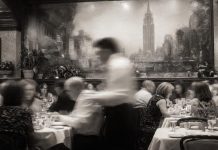 I moved out of Brooklyn Heights in 1989 for an extended stay in Los Angeles. Despite frequent visits back to New York to see friends and family, I was not prepared for the changes that have transformed the surrounding communities in the intervening years. In the 1980s, DUMBO and MetroTech were fleeting thoughts in the minds of a few developers. Smith Street south of Atlantic Avenue was run down and tired. Boerum Hill was still struggling to find a middle class base that could rescue it from years of depressed home values and unsafe streets. Downtown Brooklyn could be scary at night. But all that has changed.
I moved out of Brooklyn Heights in 1989 for an extended stay in Los Angeles. Despite frequent visits back to New York to see friends and family, I was not prepared for the changes that have transformed the surrounding communities in the intervening years. In the 1980s, DUMBO and MetroTech were fleeting thoughts in the minds of a few developers. Smith Street south of Atlantic Avenue was run down and tired. Boerum Hill was still struggling to find a middle class base that could rescue it from years of depressed home values and unsafe streets. Downtown Brooklyn could be scary at night. But all that has changed.
My wife and I took a day to walk and walk and walk in all of the neighborhoods we once knew. Starting with the Heights, we noticed that new tall apartment buildings had arisen on the fringes of the community where zoning gave developers the freedom to expand. The old housing stock, some dating back more than 200 years, has been renovated to its prior graciousness. On many streets, if you took away the cars, you would be unable to tell the year was no longer 1845. Wood-framed houses and boot scrapers can still be found on many of the tree-lined blocks.
 Walk to the north end of the Heights and visit Plymouth Church (75 Hicks Street) built in 1847 where Henry Ward Beecher railed against slavery, and even Abe Lincoln occasionally came to worship. Nearby is Jack the Horse Tavern (66 Hicks Street, jackthehorse.com), an intimate restaurant with creative and delicious food to please a wide variety of tastes. Walk a couple of blocks west toward the harbor and one of the world’s great vistas will open up to you. No one will argue that the view from the one-third mile long Promenade (really an esplanade) is beyond breathtaking because so much is happening in front of you; a new park along the waterfront to be completed in the coming months promises to be an extraordinary addition to the Brooklyn Experience. The existing parks along the water between the Brooklyn and Manhattan bridges are so welcoming that families, singles, and streams of tourists all seem content to share the space. Did I mention the views?
Walk to the north end of the Heights and visit Plymouth Church (75 Hicks Street) built in 1847 where Henry Ward Beecher railed against slavery, and even Abe Lincoln occasionally came to worship. Nearby is Jack the Horse Tavern (66 Hicks Street, jackthehorse.com), an intimate restaurant with creative and delicious food to please a wide variety of tastes. Walk a couple of blocks west toward the harbor and one of the world’s great vistas will open up to you. No one will argue that the view from the one-third mile long Promenade (really an esplanade) is beyond breathtaking because so much is happening in front of you; a new park along the waterfront to be completed in the coming months promises to be an extraordinary addition to the Brooklyn Experience. The existing parks along the water between the Brooklyn and Manhattan bridges are so welcoming that families, singles, and streams of tourists all seem content to share the space. Did I mention the views?
 DUMBO got a clever name, then transformed an area of abandoned century-old warehouses and crumbling streets into one of the trendiest young neighborhoods in New York.
DUMBO got a clever name, then transformed an area of abandoned century-old warehouses and crumbling streets into one of the trendiest young neighborhoods in New York.
Walk up from the low lying waterfront areas and you will pass by the pedestrian access path to the Brooklyn Bridge walkway. Don’t hesitate to climb the steps and stroll the half mile to the center of the span. As someone who regularly used to run over the generally empty bridge walkway 25 years ago, I was delighted to see many hundreds of people walking and taking in the sights. Look right to the Manhattan Bridge and the pointy skyline of midtown Manhattan; look left at the towers of lower Manhattan, the pulsing New York harbor, the Statue of Liberty, Governor’s Island, and even the Verrazano-Narrows Bridge.
Walk back down to Brooklyn, turn right up the short hill and walk into Cadman Park, a tiny jewel covered with mature trees and friendly places to stroll. A few blocks south to the other end of the park brings you to one of the grand old post offices in all of New York. Now a national landmark, the building merits a few moments of admiration. Another couple of blocks south brings you to Borough Hall, the former seat of government for the City of Brooklyn before it merged with New York in 1898. This Greek Revival style building was built in 1848 and is surrounded by more subway lines than any other location in all of New York.
Walk four blocks down Court Street to Atlantic Avenue which has Brooklyn’s answer to Zabar’s – Sahadi’s (187 Atlantic Ave., sahadis.com). It’s the real deal if you like Middle Eastern foods such as stuffed grape leaves, hummus, and the best babaghanouj this side of Beirut. Fresh nuts, superb coffee, dates, dozens of varieties of olives, freshly-baked pita, and wonderful people to help you find what you need. And the prices are surprisingly reasonable.
 Walk a block east to Smith Street, which has become populated with dozens of interesting restaurants and bars, then head south. If you have the time, stop for dinner at Restaurant Saul (149 Smith Street, saulrestaurant.com). Great food, professional service (Saul still runs the place after ten years), and a pleasant ambiance make the moderately-priced meal enjoyable on every level.
Walk a block east to Smith Street, which has become populated with dozens of interesting restaurants and bars, then head south. If you have the time, stop for dinner at Restaurant Saul (149 Smith Street, saulrestaurant.com). Great food, professional service (Saul still runs the place after ten years), and a pleasant ambiance make the moderately-priced meal enjoyable on every level.
If you have the energy, walk back to the Promenade for one of the world’s great nighttime vistas. The ferries, water taxis, helicopters, jets (from Newark and LaGuardia), cruise ships, luxury yachts, and that magical skyline will leave you with special memories of the fourth largest city (i.e., if it were independent) in the United States.
How to get there: Take the 2, 3, 4, or 5 subway train heading South to Borough Hall.
Map of Featured Brooklyn Heights Locations
View A Walk Through Brooklyn Heights in a larger map










 Sarah Knapp is a Brooklyn based entrepreneur whose love for the outdoors and community building led her to the October 2013 creation of OutdoorFest. She has a BA in History, is a Wilderness First Responder and a NY state hiking, camp and boating guide. Her proudest achievement to date is reading the Aeneid in Latin.
Sarah Knapp is a Brooklyn based entrepreneur whose love for the outdoors and community building led her to the October 2013 creation of OutdoorFest. She has a BA in History, is a Wilderness First Responder and a NY state hiking, camp and boating guide. Her proudest achievement to date is reading the Aeneid in Latin.  Allison was one of our first top writers and Chief Editor but is no longer working with offMetro. Allison is a native New Yorker, who has lived in Rome, Tuscany, Melbourne, Toronto and Los Angeles. She frequently contributed travel pieces to Family Travel Forum, using her own children as guinea pigs as they travel the globe. She never missed a chance to sample local delicacies, as her love for travel goes hand-in-hand with her love for food and wine.
Allison was one of our first top writers and Chief Editor but is no longer working with offMetro. Allison is a native New Yorker, who has lived in Rome, Tuscany, Melbourne, Toronto and Los Angeles. She frequently contributed travel pieces to Family Travel Forum, using her own children as guinea pigs as they travel the globe. She never missed a chance to sample local delicacies, as her love for travel goes hand-in-hand with her love for food and wine.  Josh Laskin is a freelance travel writer and photographer based in the White Mountains of New Hampshire. When he is not at work or on the road, you can find him in the mountains snowboarding, climbing, hiking, fly fishing, mountain biking, and eating bagel bites.
Josh Laskin is a freelance travel writer and photographer based in the White Mountains of New Hampshire. When he is not at work or on the road, you can find him in the mountains snowboarding, climbing, hiking, fly fishing, mountain biking, and eating bagel bites. Annie is a travel writer, environmentalist, and surfer based in Venice, CA. She heads up our West Coast team, keeps our grammatical errors in check, and makes sure our California writers always have a plan for their next adventure. Follow Annie’s travels @annelisemcb.
Annie is a travel writer, environmentalist, and surfer based in Venice, CA. She heads up our West Coast team, keeps our grammatical errors in check, and makes sure our California writers always have a plan for their next adventure. Follow Annie’s travels @annelisemcb. Carly Pifer is a freelance writer who has been known to follow whims inspired by romantic movie scenes or colorful street style shots to India, Japan, Tunisia and Argentina. After stints living in Seoul, Boston, Paris and Los Angeles, writing and searching for something intangible, she landed somewhat steadily in Brooklyn and has begun to find inspiration in her more immediate surroundings.
Carly Pifer is a freelance writer who has been known to follow whims inspired by romantic movie scenes or colorful street style shots to India, Japan, Tunisia and Argentina. After stints living in Seoul, Boston, Paris and Los Angeles, writing and searching for something intangible, she landed somewhat steadily in Brooklyn and has begun to find inspiration in her more immediate surroundings.  Kate E. O’Hara is a New York based freelance writer and photographer who loves all things food—especially the people who make it and market it. Her writing aims to capture the essence of the food experience; the stories that go well beyond a plate of ingredients. In addition to her love of food, Kate is also known to have a hankering for red wine and craft beer. You can also find Kate on Instagram
Kate E. O’Hara is a New York based freelance writer and photographer who loves all things food—especially the people who make it and market it. Her writing aims to capture the essence of the food experience; the stories that go well beyond a plate of ingredients. In addition to her love of food, Kate is also known to have a hankering for red wine and craft beer. You can also find Kate on Instagram